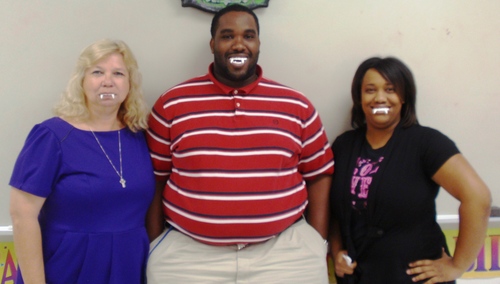Wicked Good Learning

Happy Halloween! Today, we’re celebrating the clever teachers who incorporate creepy into their curriculum to engage students. Read on, if you dare…

Emily at The Stanley Hotel
Emily Young (High School for Arts, Imagination and Inquiry – Brooklyn) investigated how places “haunt” writers and readers by exploring Salem, MA, and The Stanley Hotel (which inspired Stephen King’s The Shining) to ignite my students’ interest in reading, the writing process, and how their own places are imbued with meaning.

In a Charleston cemetery on the Ghost Tour.
Kelly Benham, Kathy Rutherford, Melissa Waterman and Ronda Hatton (Owasso 8th Grade Center – Owasso, OK) walked in the steps of patriots, pirates, slaves, soldiers and ghosts in Charleston, SC, to study the city’s influence on American history and facilitate students’ ownership of our country in a way that improves their stewardship of civil rights and duties.

Greeting Lord Byron amidst the mist of Aberdeenshire.
LaVerne McDonald, Phylecia Raglund and Stephen Howard (Ossie Ware Mitchell Middle School – Birmingham, AL) explored the British Isles’ geography, cultural influences, and historic sites that inspired Byron, Polidori and Stoker’s development of vampire legends to increase students’ interest in reading. Read more about their impact here.
“After telling students what to read for all those years, I turned it back on them and asked what they wanted to read. ‘Vampire stories’ unanimously topped the list. I decided if I could use vampires to get their attention, then I automatically get their interest and the war was won.”

At the spot memorializing the mummy’s discovery.
Kelly Houston (School for Democracy and Leadership – Brooklyn) trekked to the site of Otzi the Iceman’s death on the Tisenjoch Pass along the Italian-Austrian border and also explore artifacts related to the mummy at the South Tyrol Museum of Archaeology’s Otzi exhibit in Bolzano, Italy, to create a Forensics mastery project about possibly the oldest victim of murder and increase students’ skills and interest in science. Read more about her impact here.
“I was able to see Otzi’s body and belongings and visit Neolithic sites, Glacier museums and zoos to get a better sense of Otzi’s environment and the crime scene itself — the oldest unsolved murder case in human history. Students now study about Otzi through lessons that I created and complete a mastery project around his case, developing their own hypotheses as to why and how Otzi died and presenting their findings to peers and professionals at our annual science fair.”

Learning how disease was transmitted from a historian at the Cosmeston Medieval Village in Penarth, UK.
Tania Williams, Lanetta Koonce and David Williams (Lauderdale County High School, Rogersville, AL) tour the Center for Disease in Atlanta and research historic sites in the United Kingdom related to the Black Death to guide students’ understanding of disease transmission, the role diseases play in governmental policies and social customs, and the effects of a pandemic on literature.
“When designing our fellowship, we thought a unit on diseases would help them to make educated choices and provide them with insight as to how society is touched by sickness and death. We never dreamed how the experience itself would shape the way we teach and think. And we discovered that our research was not really about death; it was about helping our students live healthy lives. When it comes down to it, all of education should be about enriching the lives of students.”
 Back to Blogs
Back to Blogs